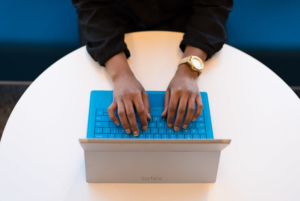The Pandemic and the Digital Divide in Jamaica
 The nationwide pause of in-person learning on March 13, 2020, underscored the glaring digital divide in Jamaica. Generally, the digital divide refers to a gap between those who do and do not have ready access to an array of technology services including computers and smartphones. However, an additional layer to the definition points to a divide in the quality of digital services.
The nationwide pause of in-person learning on March 13, 2020, underscored the glaring digital divide in Jamaica. Generally, the digital divide refers to a gap between those who do and do not have ready access to an array of technology services including computers and smartphones. However, an additional layer to the definition points to a divide in the quality of digital services.
Particularly, while an individual may possess technological devices, the quality of their internet access can interfere with their ability to use those devices effectively. In an increasingly digital economy, access to up-to-standard and high-speed technology has become a necessity. This can enable full and effective participation in the workplace and throughout educational institutions.
Background
The digital divide was highlighted following the outbreak of COVID-19 in 2020 which caused a worldwide disruption in education, leaving 90% of children impacted. The effects of this disruption were also felt through the absence of in-person education and the subsequent switch to remote, online learning.
As 34% of children in Jamaican households do not have access to a technological device and lack reliable internet access for educational purposes, concerns surrounding the ability to acquire the needed devices for remote learning were raised.
This inability to access needed technology also affected attendance in the online learning landscape. Some academic institutions saw less than 60% attendance in their virtual instruction environments. In addition, less affluent households who did manage to procure a device like a tablet found difficulty splitting the device’s time between multiple children — therefore leaving the online classroom largely unattended by numerous households.
For years, closing this digital divide in Jamaica has been a pressing concern in education among policymakers and government officials. However, with the switch to virtual instruction, there has been a redoubled effort to close the digital divide among citizens of the country.
Pandemic Effects
Caroline Dyche, a Professor at the University of the West Indies Mona Branch (UWI), spoke to the notable shift from a physical learning environment to a virtual one in Jamaica. While a regular class schedule was maintained in her Language, Linguistics and Philosophy courses, she noted the remote experience was “more problematic than effective.”
Nevertheless, Dyche mentioned various efforts put in place to facilitate learning in the midst of the adversity. Students were able to contact their professors during their scheduled office hours — two hours per week – and outside the allotted time if needed. Moreover, communication between students and professors via email was encouraged, with a number of professors participating in WhatsApp groups with students to provide assistance with inquiries if necessary.
Typically, students attended online classes through devices such as their cell phones with their data plans. However, Dyche noted that poor Wi-Fi connectivity among students would cause frequent disruptions throughout classes as students found themselves attempting to rejoin classes repeatedly. This issue of inconsistent internet connection illustrates the difficulties of remote learning as a consequence of the digital divide in Jamaica.
To address problems faced by students who did not own technological devices in the midst of virtual education, students were able to borrow tablets from UWI’s library for extended use. Furthermore, Dyche adds that the library’s online services were increasingly utilized during the pandemic — including the interactive “Ask a Librarian” feature.
Addressing the Challenge
Upon recognizing that approximately 120,000 students faced an educational setback due to unequal access to technology services, the Ministry of Education opted to host a summer catch-up program in 2021. Yet, while students did attend these summer classes, they were described as having wavering attendance alongside a short learning time.
Similarly to UWI, the use of Google Classroom, WhatsApp and phone calls were common strategies employed by Jamaican teaching professionals to continue communication and engagement with their students. For those unable to access or afford the technology required, institutions such as Little Bay Primary started a drop-off program to physically deliver lessons and assignments to their students to be picked up by the end of the week.
The country’s government also showed initiative in addressing the concerns of technological access raised by those through providing daily educational content with the Public Broadcasting Corporation of Jamaica (PBCJ). Andrew Holness, Prime Minister of Jamaica, announced that the PBCJ would broadcast this content using digital transmission technology and students without access to a Smart TV could use a digital set-top box to allow their current television to receive these transmissions.
The government also further invested in high-speed fiber-optic technology in order to improve access to cable and internet connection for those with unreliable Wi-Fi networks. In the midst of the transition, ensuring every community had access to Wi-Fi was prioritized through the installation of hotspots in locations throughout the country including Port Antonio, Ocho Rios and Annotto Bay.
Looking Forward
Although there has been a return to physical learning in Jamaica as of late 2022, the digital divide still remains an issue. The efforts to close the digital divide in Jamaica have continued in 2023 as the United Nations Development Fund (UNDP) provided a grant of $350,000 to fund the installation of 17 internet sites within community centers and schools. While the gap will be difficult to completely close, the steps taken by educational institutions, organizations and government officials towards addressing the divide during and beyond the nationwide switch to remote learning shows progress.
The work being done also furthers the United Nations’ Sustainable Development Goal for education to “ensure inclusive and equitable quality education and promote lifelong learning opportunities for all.”
– Katrina Girod
Photo: Pixabay
